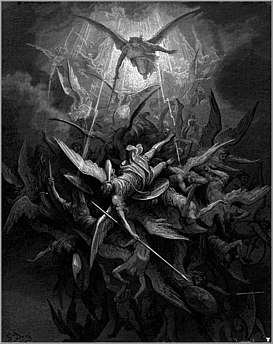Fallen angel

Fallen angels are angels who were expelled from Heaven. The literal term "fallen angel" does not appear in any Abrahamic religious texts, but is used to describe angels cast out of heaven[1] or angels who sinned. Such angels often tempt humans to sin.
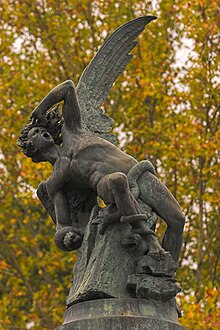
The idea of fallen angels is derived from the Book of Enoch, a Jewish pseudepigraphic apocalyptic religious text, or the assumption that the "sons of God" (בני האלוהים) mentioned in Genesis 6:1–4 are angels. In the period immediately preceding the composition of the New Testament, some sects of Second Temple Judaism identified these same "sons of God" as fallen angels. During the late Second Temple period the Nephilim were considered the monstrous offspring of fallen angels and human women. In such accounts, God sends the Great Deluge to purge the world of these creatures; their bodies are destroyed, yet their peculiar souls survive, thereafter roaming the earth as demons. Rabbinic Judaism and Christian authorities after the third century rejected the Enochian writings and the notion of an illicit union between angels and women producing hybrids. Christian theology indicates the sins of fallen angels occur before the beginning of human history. Accordingly, fallen angels became identified with those led by Lucifer in rebellion against God, also equated with demons.
In Islam, belief in fallen angels is disputed. In early Quranic exegesis (tafsīr) there are two distinct opinions in regards of the obedience of angels, often revolving around the nature of Iblis (Satan in Islam).[2] According to the viewpoint of ibn Abbas (619–687), Iblis was an angel created from fire (nār as-samūm), while according to Hasan of Basra (642–728), he was the progenitor of the jinn.[3][4] Hasan al-Basri argued that angels are unable to sin. To eliminate the possibilities for fallen angels, he further interpretates Harut and Marut, mentioned in 2:102, as malikayn (kings) instead of malā'ikah (angels).[5] Ibn Abbas, on the other hand, asserts that the verse in Surah 18:50 "except Iblis, he was one of the jinn", means "he was one of the inhabitants of paradise" and generally allows the concept of fallen angels within Islamic tradition.[2]
Academic scholars have discussed whether or not the Quranic jinn are identical to the biblical fallen angels. Although the different types of spirits in the Quran are sometimes hard to distinguish, the jinn in Islamic traditions seem to differ in their major characteristics from fallen angels.[1] In classical Islamic traditions, the jinn are often thought of as a race of Pre-Adamites,[6] who dwelt on earth. However, their ethereal bodies, as in the Christian conception of fallen angels, would allow them to ascend to heaven to obtain knowledge, thus passing secret information to soothsayers (a notion also corresponding with the Greek Daimon). The Quran also refers to the idea of jinn trying to climb up to heaven. As Patricia Crone points out, one of the characteristics of fallen angels is that they fall from heaven, not that they try to get back to it.[1]
Second Temple period
The concept of fallen angels derives mostly from works dated to the Second Temple period between 530 BC and 70 AD: in the Book of Enoch, the Book of Jubilees and the Qumran Book of Giants; and perhaps in Genesis 6:1–4.[7] A reference to heavenly beings called "Watchers" originates in Daniel 4, in which there are three mentions, twice in the singular (v. 13, 23), once in the plural (v. 17), of "watchers, holy ones". The Ancient Greek word for watchers is ἐγρήγοροι (egrḗgoroi, plural of egrḗgoros), literally translated as "wakeful".[8] Some scholars consider it most likely that the Jewish tradition of fallen angels predates, even in written form, the composition of Gen 6:1–4.[9][10][a] In the Book of Enoch, these Watchers "fell" after they became "enamored" with human women. The Second Book of Enoch (Slavonic Enoch) refers to the same beings of the (First) Book of Enoch, now called Grigori in the Greek transcription.[12] Compared to the other Books of Enoch, fallen angels play a less significant role in 3 Enoch. 3 Enoch mentions only three fallen angels called Azazel, Azza and Uzza. Similar to The first Book of Enoch, they taught sorcery on earth, causing corruption.[13] Unlike the first Book of Enoch, there is no mention of the reason for their fall and, according to 3 Enoch 4.6, they also later appear in heaven objecting to the presence of Enoch.
1 Enoch
According to 1 Enoch 7.2, the Watchers become "enamoured" with human women as punishment. Further, Azazel is blamed for the corruption of earth:
1 Enoch 10:12: "All the earth has been corrupted by the effects of the teaching of Azazyel. To him therefore ascribe the whole crime."
An etiological interpretation of 1 Enoch deals with the origin of evil. By shifting the origin of mankind's sin and their misdeeds to illicit angel instruction, evil is attributed to something supernatural from without. This motif, in 1 Enoch, differs from that of later Jewish and Christian theology; in the latter evil is something from within.[16] According to a paradigmatic interpretation, 1 Enoch might deal with illicit marriages between priests and women. As evident from Leviticus 21:1–15, priests were prohibited to marry impure women. Accordingly, the fallen angels in 1 Enoch are the priests counterpart, who defile themselves by marriage. Just like the angels are expelled from heaven, the priests are excluded from their service at the altar. Unlike most other apocalyptic writings, 1 Enoch reflects a growing dissatisfaction with the priestly establishments in Jerusalem in the 3rd century BC. The paradigmatic interpretation parallels the Adamic myth in regard of the origin of evil: In both cases, transcending one's own limitations inherent in their own nature causes their fall. This contrasts the etiological interpretation, which implies another power besides God, in heaven. The latter solution therefore poorly fits into monotheistic thought.[17] Otherwise, the introduction to illicit knowledge might reflect a rejection of foreign Hellenistic culture. Accordingly, the fallen angels represent creatures of Greek mythology, which introduced forbidden arts, used by Hellenistic kings and generals, resulting in oppression of Jews.[18]
2 Enoch
The concept of fallen angels is also in the
Strikingly, the text refers to the leader of the Grigori as Satanail and not as Azael or Shemyaza, as in the other Books of Enoch.[20] But the Grigori are identified with the Watchers of 1 Enoch.[21][22]
The narration of the Grigori in 2 Enoch 18:1–7, who went down on to earth, married women and "befouled the earth with their deeds", resulting in their confinement under the earth, shows that the author of 2 Enoch knew about the stories in 1 Enoch.
Jubilees
The
Lord, Creator, let some of them remain before me, and let them harken to my voice, and do all that I shall say unto them; for if some of them are not left to me, I shall not be able to execute the power of my will on the sons of men; for these are for corruption and leading astray before my judgment, for great is the wickedness of the sons of men. (10:8)
Both the (first) Book of Enoch and the Book of Jubilees include the motif of angels introducing evil to humans. However, unlike the Book of Enoch, the Book of Jubilees does not hold that evil was caused by the fall of angels in the first place, although their introduction to sin is affirmed. Further, while the fallen angels in the Book of Enoch are acting against God's will, the fallen angels and demons in the Book of Jubilees seem to have no power independent from God but only act within his power.[30]
Rabbinic Judaism
Early Rabbinic literature
Although the concept of fallen angels developed from Judaism during the Second Temple period, rabbis from the second century onward turned against the Enochian writings, probably in order to prevent fellow Jews from worship and veneration of angels. Thus, while many angels were individualized and sometimes venerated during the Second Temple period, the status of angels was degraded to a class of creatures on the same level of humans, thereby emphasizing the omnipresence of God. The 2nd-century rabbi Shimon bar Yochai cursed everyone who explained the term sons of God as angels. He stated sons of God were actually sons of judges or sons of nobles. Evil was no longer attributed to heavenly forces, now it was dealt as an "evil inclination" (yetzer hara) within humans.[31] In some Midrashic works, the "evil inclination" is attributed to Samael, who is in charge of several satans in order to test humanity.[32][33] Nevertheless, these angels are still subordinate to God; the reacceptance of rebel angels in Midrashic discourse was posterior and probably influenced by the role of fallen angels in Islamic and Christian lore.[34]
Post-Talmudic works
The idea of rebel angels in Judaism reappears in the
Kabbalah
Although not strictly speaking fallen, evil angels reappear in Kabbalah. Some of them are named after angels taken from the Enochian writings, such as Samael.[36] According to the Zohar, just as angels can be created by virtue, evil angels are an incarnation of human vices, which derive from the qlippoth, the representation of impure forces.[37]
However, the Zohar also recalls a narration of two angels in a fallen state, called
Christianity
-
The Fall of the Rebel Angels (Apocryphal) (c. 1250), by William de Brailes. God sits on a throne within a mandorla. The rebelling angels are depicted as falling out of heaven and into a hell, in the shape of a mouth. As they fall, the angels become demons.
-
Angels fighting against fallen angels during the War in Heaven. Illustration by Gustave Doré for John Milton's Paradise Lost (1866)
Bible
Luke 10:18 refers to "Satan falling from heaven" and Matthew 25:41 mentions "the Devil and his angels", who will be thrown into hell. All
The
Origen and other Christian writers linked the fallen morning star of Isaiah 14:12 of the Old Testament to Jesus' statement in Luke 10:18 that he "saw Satan fall like lightning from heaven", as well as a passage about the fall of Satan in Revelation 12:8–9.[47] The Latin word lucifer, as introduced in the late 4th-century AD Vulgate, gave rise to the name for a fallen angel.[48]
Christian tradition has associated Satan not only with the image of the morning star in Isaiah 14:12, but also with the denouncing in Ezekiel 28:11–19 of the king of Tyre, who is spoken of as having been a "cherub". The Church Fathers saw these two passages as in some ways parallel, an interpretation also testified in apocryphal and pseudepigraphic works.[49] However, "no modern evangelical commentary on Isaiah or Ezekiel sees Isaiah 14 or Ezekiel 28 as providing information about the fall of Satan".[50]
Early Christianity
During the period immediately before the rise of Christianity, the intercourse between the Watchers and human women was often seen as the first fall of the angels.
The Babylonian king, who is described as a fallen "morning star" in Isaiah 14:1–17, was probably the first time identified with a fallen angel by Origen.[59][60] This description was interpreted typologically both as an angel and a human king. The image of the fallen morning star or angel was thereby applied to Satan by early Christian writers,[61][62] following the equation of Lucifer to Satan in the pre-Christian century.[63]
Catholicism
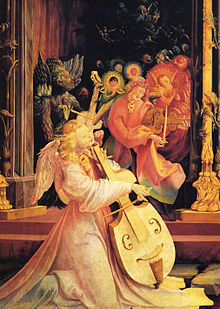

The subject of fallen angels is covered in a number of
In terms of the history of fallen angel theology it is thought to be rooted in Enochian literature, which Christians began to reject by the third century. The sons of God came to be identified merely with righteous men, more precisely with descendants of Seth who had been seduced by women descended from Cain. The cause of evil was shifted from the
Augustine, in his Civitas Dei describes two cities (Civitates) distinct from each other and opposed to each other like light and darkness.
Orthodox Christianity
Eastern Orthodox Christianity
Like Catholicism,
Ethiopian Church
Unlike most other Churches, the Ethiopian Church accepts 1 Enoch and the Book of Jubilees as canonical.[87] As a result, the Church believes that human sin does not originate in Adam's transgression alone, but also from Satan and other fallen angels. Together with demons, they continue to cause sin and corruption on earth.[88]
Neutral angels
In Christian folklore tales about encounters between men and spirits, the spirits were often explained as fallen angels. They would have been cast out of heaven, damned to roam the world as demons, but were not so evil that they were sentenced to hell, like Lucifer and his devils. Yet they were still not as good to remain in heaven.[89] Therefore, they would live between heaven and hell among humans in liminal spaces.
Caesarius of Heisterbach's (c. 1180 – c. 1240) asserted that not all fallen angels are equally bad. Some fallen angels would be banished for not actively defending God against Lucifer, but since they did not side with the devils, would not be sentenced to hell. They remain loyal to God on earth, do good deeds, and bearing some resemblances to saints, as seen in the Dialogus Miraculorum, in which a knight is guided by a fallen angel to lead him back on the path of piety.[90] In another tale, a neutral fallen angel became an assistant of a noble knight. However, when the knight learned that his best assistant was actually a demon, he dismissed him. When the knight wants to pay the demon for his service, the demon asserted that the knight should spend the money on a new bell for the church, instead.[90]
According to The Brendan Voyage, during the Medieval Age, Brendan meets a group of angels referred to as "wandering spirits". On holy days, they were embodied as white birds, symbols usually used for purity and the holy spirit. In later versions, such as the 15th Century Dutch and German variant, the fallen angels are much more depicted as akin to grotesque demons. Although they would not have supported Lucifer in his evil schemes, they would have been passive and not fighting for good, thus turned into animal-like creatures cast out of heaven.
Such earthly fallen angels were used as a possible origin of fairies in Irish and Scandinavian folk-tales. Depending on the place they fell, they will remain as spirits of the specific element, but are usually benevolent and harmless.[91] If such fairies were identified with the Biblical fallen angels, their salvation after Judgement Day was usually denied, since the fallen angels could not return to heaven.[92] Later Protestant thinkers increasingly dismissed belief in fairies and neutral angels as part of either fairy-tales or a delusion cast by Satan.[93]
Protestantism

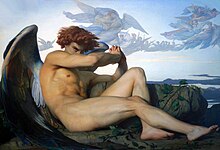
Like Catholicism, Protestantism continues with the concept of fallen angels as spiritual entities unrelated to flesh,
Philosophy
In Western philosophy, the devil was understood as a personal identity of evil in opposition to good. Its conception as a fallen angel, in contrast to Manichaeistic absolute evil, allowed to avoid two separate ontological principles.[96]
Theodicy, the question of how evil can exist simultaneously with the existence of an all-powerful and all-good God, may utilize the concept of fallen angels to explain natural evil. Accordingly, the angels would have great power, and by exercising havoc over the earth, they cause suffering and misery, manifesting in natural disasters. Accordingly, natural evil can be traced back to free-will (in that case of super-human agents). Opponents argue that this implies that fallen angels have supernatural powers to influence the world, powers left unproven, thus falling into a devil of the gaps.[97]
Islam

The concept of fallen angels is debated in Islam.
Contemporary Muslim scholars have argued, even if fallen angels are considered, they are conceptually different from the fallen angels in Christianity, since they remain at the service of God and do not become God's enemies.[103] It has been stated that "(...) according to Christianity, the devils are fallen angels who renounced their loyalty to God, in Islam it is God who dismissed the fallen angels".[2]
The Quran mentions the fall of Iblis in several
Some recent non-Islamic scholars suggest
Iblis
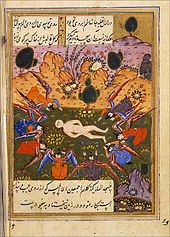
The Quran repeatedly tells about the fall of Iblis. According to
On the other hand, the tradition from ibn Abbas allows the concept of fallen angels.[2] According to Ibn Abbas, angels who guard the jinan (here: heavens) are called Jinni, just as humans who were from Mecca are called Mecci (nisba), but they are not related to the jinn-race.[116][117] This tradition asserts that Iblis and his angels are made from "poisonous fire" (nār as-samūm), the rest of the angels from "light" (Nūr), and the jinn mentioned in the Quran were created from "a mixture of fire" (mārijin min nār).[2] Other scholars assert that a jinn is everything hidden from human eye, both angels and other invisible creatures, thus including Iblis to a group of angels.
In Surah 15:36, God grants Iblis' request to prove the unworthiness of humans. Surah 38:82 also confirms that Iblis' intrigues to lead humans astray are permitted by God's power.[118] However, as mentioned in Surah 17:65, Iblis' attempts to mislead God's servants are destined to fail.[118] The Quranic episode of Iblis parallels another wicked angel in the earlier Books of Jubilees: Like Iblis, Mastema requests God's permission to tempt humanity, and both are limited in their power, that is, not able to deceive God's servants.[119] However, the motif of Iblis' disobedience derives not from the Watcher mythology, but can be traced back to the Cave of Treasures, a work that probably holds the standard explanation in Proto-orthodox Christianity for the angelic fall of Satan.[113] According to this explanation, Satan refuses to prostrate himself before Adam, because he is "fire and spirit" and thereupon Satan is banished from heaven.[120][113] Unlike the majority opinion in later Christianity, the idea that Iblis tries to usurp the throne of God is alien to Islam and due to its strict monotheism unthinkable.[121]
Harut and Marut
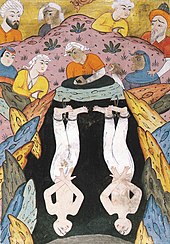
Harut and Marut are a pair of angels mentioned in Surah 2:102 teaching magic. Although the reason behind their stay on earth is not mentioned in the Quran, the following narration became canonized in Islamic tradition.
Probably the names Harut and Marut are of
Literature and popular culture

In the Divine Comedy (1308–1320) by Dante Alighieri, fallen angels guard the City of Dis surrounding the lower circles of hell. They mark a transition: While in previous circles, the sinners are condemned for sins they just could not resist, later on, the circles of hell are filled with sinners who deliberately rebel against God, such as fallen angels or Christian heretics.[131]
In
The idea of fallen angels plays a significant role in the various poems of Alfred de Vigny. In Le Déluge (1823),[137] the son of an angel and a mortal woman learns from the stars about the great deluge. He seeks refuge with his beloved on Mount Ararat, hoping that his angelic father will save them. But since he does not appear, they are caught by the flood. Éloa (1824) is about a female angel created by the tears of Jesus. She hears about a male angel, expelled from heaven, whereupon she seeks to comfort him, but goes to perdition as a consequence.[138]
The Turkish horror film Semum (2008 ), produced and directed by Hasan Karacadağ, is about a shayṭān who has been summoned from hell to torment a woman named Canan. The movie is based on the ibn Abbas interpretation of the Quran and depicts the devil as a fallen angel who seeks revenge on humans for being abandoned by God (Allah). The devil accepts ʿAzāzīl as his new deity, who is praised as the ruler of hell and supporting his minions against God's new creation (humans). However, at the end, the movie affirms in accordance with Islamic teachings, that ʿAzāzīl has no real power but only to seduce people to follow him. When the shayṭān battles a human priest (Hoca) in hell, it is God who intervenes on behalf of humanity while ʿAzāzīl has forsaken his servant. By that, the movie further rejects dualism in favor of Islamic tawḥīd, emphazising that even hell is under God's control.[139]
See also
Notes
- ^ Lester L. Grabbe calls the story of the sexual intercourse between angels and women "an old myth in Judaism". Further, he states: "the question of whether the myth is an interpretation of Genesis or whether Genesis represents a brief reflection of the myth is debated."[11]
- ^ "There is no unanimity among scholars when it comes to the sinlessness of angels. The majority, of course, take the view that they are sinless. They start from the Quran and refer to individual verses that speak for it, such as (66: 6 and (21:20). Hasan is counted among as one of the first representatives of this doctrine, but he obviously appears to be one step further than his contemporaries: he did not settle for the verses that speak for it, but tried to reinterpret the verses that speak against it differently." "In der Frage nach der Sündlosigkeit der Engel herrscht keine Einstimmigkeit unter den Gelehrten. Die Mehrheit vertritt freilich, die Ansicht, dass sie sündlos sind. Sie geht vom Koran aus und beruft sich auf einzelne Verse, die dafür sprechen, wie zum Beispiel (66:6 und (21:20). Zu ihnen wird Hasan als einer der ersten Vertreter dieser Lehre gezählt. Er scheint aber offentsichtlich noch einen Schritt weiter mit dieser Frage gekommen zu sein als seine Zeitgenossen. Er begnüngte sich nicht mit den Versen, die dafür sprechen, sondern versuchte, auch die Verse, die gerade dagegen sprechen, anders zu interpretieren."[99]
- ^ Nevertheless, a narrative attributed to Ibn Hazm states that the angel Sandalphon blamed the Jews for venerating Metatron as "son of God" "10 days each year".[110]
Citations
- ^ ISBN 978-3-11-044545-9Q 72
- ^ a b c d e f g Erdağı, Deniz Özkan. "Evil in Turkish Muslim horror film: the demonic in “Semum”." SN Social Sciences 4.2 (2024): 1-22.
- ^ Akbari, Mahtab, and Reza Ashrafzadeh. "A comparative study of the image of the devil in the logic of Attar Attar and the commentary of Abolfotuh Razi." Propósitos y representaciones 9.2 (2021): 100.
- ^ Öztürk, Mustafa. "The Tragic Story of Iblis (Satan) in the Qur’an." Journal of Islamic Research 2.2 (2009): 128-144.
- ISBN 978-90-04-14948-9, p. 864
- ISBN 978-0-8156-5070-6p. 39
- ISBN 978-0-567-08506-1), p. 101
- ^ ἐγρήγορος Archived 11 March 2014 at the Wayback Machine. Henry George Liddell. Robert Scott. A Greek–English Lexicon revised and augmented throughout by Sir Henry Stuart Jones with the assistance of Roderick McKenzie. Oxford. Clarendon Press. 1940. p. 474. Available online at the Perseus Project Texts Loaded under PhiloLogic (ARTFL project) at the University of Chicago.
- ISBN 978-0-567-04352-8), p. 344
- ISBN 978-90-04-07100-1), p. 14
- ^ Grabbe 2004, p. 101
- ISBN 978-1-4384-3951-8), p. 164
- ISBN 978-0-521-85378-1p. 256
- ^ a b Laurence, Richard (1883). "The Book of Enoch the Prophet".
- ISBN 978-1-139-45398-1p. 60
- ISBN 978-0-521-85378-1p. 6
- ^ SUTER, DAVID. Fallen Angel, Fallen Priest: The Problem of Family Purity in 1 Enoch 6—16. Hebrew Union College Annual, vol. 50, 1979, pp. 115–135. JSTOR,
- ^ George W. E. Nickelsburg. "Apocalyptic and Myth in 1 Enoch 6–11." Journal of Biblical Literature, vol. 96, no. 3, 1977, pp. 383–405
- ISBN 978-1-139-44687-7pp. 103–104
- ^ ISBN 978-90-04-23014-9pp. 150, 164
- ^ Orlov 2011, p. 164
- ^ Anderson 2000, p. 64: "In 2 Enoch 18:3... the fall of Satan and his angels is talked of in terms of the Watchers (Grigori) story, and connected with Genesis 6:1–4."
- ISBN 978-0-19-532713-7p. 108
- ^ "The Book of Enoch the Prophet: Chapter I-XX". www.sacred-texts.com.
- ISBN 978-1-58983-643-3p. 57
- ISBN 978-1-58983-643-3p. 59
- ISBN 978-0-521-85378-1p. 90
- ^ ISBN 978-3-16-150858-5p. 112
- ISBN 978-0-8014-9409-3p. 193
- ISBN 978-1-58983-643-3p. 60
- ^ https://www.hs.ias.edu/files/Crone_Book_of_Watchers.pdf Archived 2019-09-23 at the Wayback Machine: Patricia Crone. The Book of Watchers in the Qurān, p. 6 (from The Qurʾānic Pagans and Related Matters: Collected Studies in Three Volumes, Band 1)
- ISBN 978-0-7387-4814-6
- ISBN 978-0-300-19014-4
- ISBN 978-0-521-85378-1p. 266
- ^ ISBN 978-90-04-18061-1pp. 77–80
- ISBN 978-0-19-973004-9. Retrieved 2012-07-03
- ISBN 978-1-317-58888-7p. 109
- ^ a b Michael Laitman, The Zohar
- ISBN 978-0-691-05833-7p. 48
- ^ a b c d Martin, Dale Basil. When Did Angels Become Demons? Journal of Biblical Literature, vol. 129, no. 4, 2010, pp. 657–677. JSTOR, https://www.jstor.org/stable/25765960.
- ^ J. Daryl Charles The Angels under Reserve in 2 Peter and Jude Bulletin for Biblical Research Vol. 15, No. 1 (2005), pp. 39–48
- ^ Revelation 12:4
- ^ Revelation 12:9
- ISBN 978-0-8423-3960-5.
- ISBN 978-3-16-159873-9.
- ISBN 978-90-04-17122-0.
- ISBN 978-0-8028-2529-2. Retrieved 3 July 2012.
- ^ Kaufmann Kohler Heaven and Hell in Comparative Religion: With Special Reference to Dante's Divine Comedy Macmillan original: Princeton University 1923 digitized: 2008 p. 5
- ISBN 978-90-04-20722-6, pp. 76–78
- ISBN 978-1-921817-99-1), p. 246.
- ISBN 978-0-8308-1885-3, p. 138
- ^ a b Patricia Crone. The Book of Watchers in the Qurān, p. 4
- ^ a b Reed 2005, pp. 14, 15
- ISBN 978-0-521-85378-1p. 149
- ISBN 978-90-04-35061-8p. 30
- ISBN 978-0-521-85378-1p. 163
- ISBN 978-0-521-85378-1p. 162
- ISBN 978-0-8204-7257-7p. 127
- ISBN 978-0-8014-9413-0p. 130
- ISBN 978-0-85773-488-4p. 42
- ^ Charlesworth 2010, p. 149
- ^ Schwartz 2004, p. 108
- ^ "Lucifer". Jewish Encyclopedia. Retrieved 11 March 2014.
- ^ Hay, Rev. George (1871). . Works of the Right Rev. Bishop Hay of Edinburgh. William Blackwood and Sons.
- ^ Reed 2005, p. 218
- ^ Patricia Crone. The Book of Watchers in the Qurān, p. 5
- ^ ISBN 978-90-04-35061-8p. 39
- ISBN 978-90-232-2653-6), p. 253
- ^ ISBN 978-90-04-35061-8p. 42
- ^ ISBN 978-0-19-956050-9p. 77
- ^ ISBN 978-90-04-35061-8p. 40
- ISBN 978-90-04-35061-8p. 49
- ISBN 978-0-8014-9413-0p. 210
- ISBN 978-90-04-35061-8p. 45
- ^ ISBN 978-3-05-005040-9p. 158
- ISBN 978-0-691-01474-6p. 405
- ISBN 978-0-8014-9413-0p. 211
- ISBN 978-90-04-35061-8p. 47
- ISBN 978-0-19-956050-9p. 72
- ISBN 978-90-04-35061-8p. 44
- ^ "Catechism of the Catholic Church, "The Fall of the Angels" (391–395)". Vatican.va. Archived from the original on 4 September 2012. Retrieved 3 July 2012.
- ISBN 978-0-8160-7565-2p. 226
- ISBN 978-1-4008-8439-1p. 141
- ISBN 978-1-351-30474-0p. 52
- ^ ISBN 978-0-88141-051-8p. 128
- ISBN 978-1-4008-8439-1p. 147
- ISBN 978-0-88414-118-1p. 133
- ISBN 978-1-59856-491-4p. 10
- ^ Mack, C. K., Mack, D. (1998). A Field Guide to Demons, Fairies, Fallen Angels, and Other Subversive Spirits. USA: Arcade Pub. p. xxiii
- ^ a b Newman, Coree. "The Good, the Bad and the Unholy: Ambivalent Angels in the Middle Ages." Fairies, Demons, and Nature Spirits: 'Small Gods' at the Margins of Christendom (2018): 103-122.
- ^ Wilde, J. F. E. (1888). Ancient Legends, mystic Charms, and Superstitions of Ireland: With Sketches of the Irish Past. To which is Appended a Chaper on "The Ancient Race of Ireland". USA: Ticknor and Company. p. 89
- doi:10.2307/20521348
- ^ Oldridge, Darren. "Fairies and the Devil in early modern England." The Seventeenth Century 31.1 (2016): 1-15.
- ISBN 978-0-521-84332-4p. 74
- ISBN 978-0-521-84332-4p. 76
- ^ Karl Rahner, “Devil - The Devil”, in: Sacramentum Mundi Online, General Editor Karl Rahner, SJ. Consulted online on 08 February 2024 <http://dx.doi.org/10.1163/2468-483X_smuo_COM_001082> First published online: 2016
- ^ Dunnington, Kent. "The Problem with the Satan Hypothesis: Natural Evil and Fallen Angel Theodicies." Sophia 57.2 (2018): 265-274.
- ^ Welch, Alford T. (2008) Studies in Qur'an and Tafsir. Riga, Latvia: Scholars Press. p. 756.
- ISBN 978-3-447-05349-5pp. 291–292 (German)
- ISBN 978-0-87395-727-4p. 74
- ISBN 978-90-04-14948-9, p. 864
- ISBN 978-0-8156-5084-3p. 189
- ^ Serdar, Murat. "Hıristiyanlık ve İslâm’da Meleklerin Varlık ve Kısımları." Bilimname 2009.2 (2009).
- ^ T.C. t.c Istanbul Bilimler Enstitütüsü Sosyal Bilimler Enstitüsü Temel Islam bilimeri Anabilim dali yüksek Lisans Tezi Imam Maturidi'nin Te'vilatu'l-Kur'an'da gaybi Konulara Yaklasimi Elif Erdogan 2501171277 Danisman Prof. Dr. Yaşar Düzenli İstanbul 202
- ISBN 978-90-04-12668-8p. 161
- ISBN 978-0-85773-063-3p. 30
- ISBN 978-1-5199-5237-0
- ^ Kohlberg, Etan. "In Praise of the Few. Studies in Shiʿi Thought and History." In Praise of the Few. Studies in Shiʿi Thought and History. Brill, 2020. p. 389
- ISBN 978-1-4008-6413-3p. 183
- ISBN 978-1-4008-6273-3p. 32
- ^ Patricia Crone. The Book of Watchers in the Qurān, p. 16
- ^ Q2:30, 50+ translations, islamawakened.com
- ^ ISBN 978-90-04-33481-6p. 66
- ISBN 978-90-04-33481-6p. 70
- ISBN 978-3-11-020094-2p. 38
- ^ Al-Tabari J. Cooper W.F. Madelung and A. Jones The commentary on the Quran by Abu Jafar Muhammad B. Jarir al-Tabari being an abbridged translation of Jamil' al-bayan 'an ta'wil ay al-Qur'an Oxford University Press Hakim Investment Holdings p. 239
- ISBN 978-0-7914-9546-9p. 75
- ^ ISBN 978-90-04-33481-6p. 71
- ISBN 978-90-04-33481-6p. 72
- ISBN 978-90-04-34708-3p. 83
- ISBN 978-0-8156-5070-6p. 45
- ISBN 978-1-136-50474-7p. 8
- ISBN 978-0-8156-5070-6p. 40
- ISBN 978-90-04-18130-4, 2009, 2009-3
- ISBN 978-1-136-45991-7p. 155
- ^ Patricia Crone. The Book of Watchers in the Qurān, p. 10
- ^ Patricia Crone. The Book of Watchers in the Qurān, pp. 10–11
- ^ Patricia Crone. The Book of Watchers in the Qurān, p. 11
- ^ Annette Yoshiko Reed Fallen Angels and the Afterlives of Enochic Traditions in Early Islam University of Pennsylvania 2015 p. 6
- ISBN 978-90-04-33481-6p. 78
- ISBN 978-0-226-25888-1p. 70
- ISBN 978-1-134-94950-2chapter 5
- ^ a b Biljana Ježik The Fallen Angels in Milton's Paradise Lost Osijek, 2014 p. 4
- ^ Biljana Ježik The Fallen Angels in Milton's Paradise Lost Osijek, 2014 p. 2
- ISBN 978-3-11-091937-0pp. 54, 59
- ISBN 978-3-11-091937-0p. 60
- ISBN 978-0-8139-1177-9p. 157
- ISBN 978-0-8276-0797-2p. 4
- ^ Erdağı, D. Evil in Turkish Muslim horror film: the demonic in “Semum”. SN Soc Sci 4, 27 (2024). https://doi.org/10.1007/s43545-024-00832-w
References
- Anderson, Gary, ed. (2000). Literature on Adam and Eve. Leiden: Brill. ISBN 978-90-04-11600-9.
- Bamberger, Bernard J. (2006). Fallen angels : soldiers of Satan's realm (first paperback ed.). Philadelphia, Pa.: Jewish Publ. Soc. of America. ISBN 978-0-8276-0797-2.
- Charlesworth, James H., ed. (2010). The Old Testament pseudepigrapha. Peabody, Mass.: Hendrickson. ISBN 978-1-59856-491-4.
- ISBN 978-0-02-907052-9.
- DDD, Karel van der Toorn, Bob Becking, Pieter W. van der Horst (1998). Dictionary of deities and demons in the Bible (DDD) (2., extensively rev. ed.). Leiden: Brill. ISBN 978-90-04-11119-6.)
{{cite book}}: CS1 maint: multiple names: authors list (link - Douglas, James D.; Merrill, Chapin Tenney; Silva, Moisés, eds. (2011). Zondervan Illustrated Bible Dictionary. Grand Rapids, Mich.: Zondervan. ISBN 978-0-310-22983-4.
- Orlov, Andrei A. (2011). Dark mirrors: Azazel and Satanael in early Jewish demonology. Albany: State University of New York Press. ISBN 978-1-4384-3951-8.
- Reed, Annette Yoshiko (2005). Fallen angels and the history of Judaism and Christianity : the reception of Enochic literature (1. publ. ed.). Cambridge [u.a.]: ISBN 978-0-521-85378-1.
- ISBN 978-0-19-508679-9.
- Wright, Archie T. (2004). The origin of evil spirits the reception of Genesis 6.1–4 in early Jewish literature. Tübingen: Mohr Siebeck. ISBN 978-3-16-148656-2.
Further reading
- ISBN 978-1-61608-333-5.
External links
- Catholic Encyclopedia: Angels, see section "The Evil Angels"
- Jewish Encyclopedia: Fall of Angels


